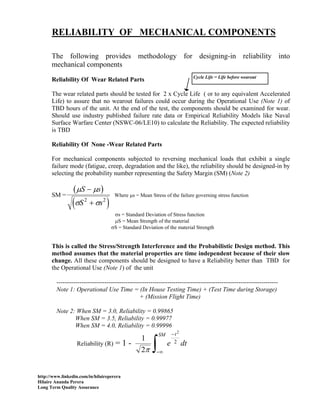Mechanical component reliability
- 1. RELIABILITY OF MECHANICAL COMPONENTS The following provides methodology for designing-in reliability into mechanical components Cycle Life = Life before wearout Reliability Of Wear Related Parts The wear related parts should be tested for 2 x Cycle Life ( or to any equivalent Accelerated Life) to assure that no wearout failures could occur during the Operational Use (Note 1) of TBD hours of the unit. At the end of the test, the components should be examined for wear. Should use industry published failure rate data or Empirical Reliability Models like Naval Surface Warfare Center (NSWC-06/LE10) to calculate the Reliability. The expected reliability is TBD Reliability Of None -Wear Related Parts For mechanical components subjected to reversing mechanical loads that exhibit a single failure mode (fatigue, creep, degradation and the like), the reliability should be designed-in by selecting the probability number representing the Safety Margin (SM) (Note 2) SM = ( ┬ĄS ŌłÆ ┬Ąs ) (ŽāS 2 + Žās 2 Where ┬Ąs = Mean Stress of the failure governing stress function ) Žās = Standard Deviation of Stress function ┬ĄS = Mean Strength of the material ŽāS = Standard Deviation of the material Strength This is called the Stress/Strength Interference and the Probabilistic Design method. This method assumes that the material properties are time independent because of their slow change. All these components should be designed to have a Reliability better than TBD for the Operational Use (Note 1) of the unit ---------------------------------------------------------------------------------------------------------Note 1: Operational Use Time = (In House Testing Time) + (Test Time during Storage) + (Mission Flight Time) Note 2: When SM = 3.0, Reliability = 0.99865 When SM = 3.5, Reliability = 0.99977 When SM = 4.0, Reliability = 0.99996 Reliability (R) =1- http://www.linkedin.com/in/hilaireperera Hilaire Ananda Perera Long Term Quality Assurance 1 2ŽĆ Ōł½ SM ŌłÆŌł× ŌłÆt2 e 2 dt

